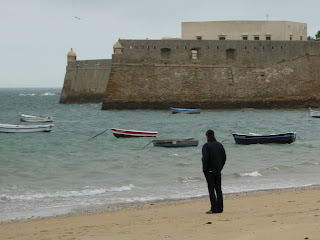
Thursday, December 30, 2010
The Philippines is ... well ... different - part one

Monday, December 6, 2010
Take THAT Colonel Gaddafi! … and other Mediterranean ramblings - part ten

The best time at sea is early morning. About a half hour before sunrise, I find a coffee or tea and have a wander.
I'm often surprised that a ship seems entirely mine. The decks - in this case, Discovery's traditional promenade with its teak steamer chairs - are empty as the horizon.
Lounges are silent.
I've waited until our week-long crossing of the Atlantic - from Cadiz to Madeira to the Caribbean - to write about the ship. Other than Libya, I wanted to see the Discovery as there aren't many like her still sailing. Her passengers are more likely to appreciate ships as ships rather than as floating resorts.
This is a publicity shot.
By today's standards, she's tiny, an eleventh of the gross tonnage of the world's currently biggest cruise ship. Discovery has a few hundred passengers while the Oasis of the Seas carries 6,300 and is more than double Discovery's length.
Just look at Discovery in Valetta's Grand Harbour ahead of a more modern ship, the Costa Pacifica.
Or the view from our stern as, coming into Funchal, Madeira, we pass the depressingly enormous MSC Fantasia.
Here's a shot from Discovery as the Queen Mary 2 comes into Bridgetown, Barbados. Although huge, she has some of the transatlantic liner's classic lines and the potted plants on her bridge provided an unexpectedly homey touch.
A quick aside: while the QM2 was berthed, some crew members were doing maintenance. Beneath the colossal liner's bow, they bobbed in what was virtually a punt with a pipsqueak outboard. The punt bravely bore the grand name QM2.
Discovery was launched in 1971. She's the former Island Princess, sister to the Pacific Princess, TV's ‘Love Boat’. Apparently she substituted for her sister in some episodes. What many passengers don't know is that, under another name, she ferried South Koreans to a scenic part of North Korea during a brief period of tepid detente. The galleys served up kimchi and the lounge in the picture below had karaoke booths, thankfully gone.

After a South Korean passenger was shot by a North Korean soldier, Discovery was forced to find new ports and new owners.
She does have choir practice and a passenger talent show (which I assiduously avoided), jigsaw puzzles and shuffleboard.
To be fair, there's a lot more than singing, genteel deck sports and afternoon tea in the Palm Court. Discovery has a superb lecture program with topics from history to ecology to international affairs.
Her size allows ports impossible for larger ships. Here she is, conveniently at the end of a street in Trapani, an easy dash for a bathroom, if I can't remember the Italian.
Discovery is a quirky old thing with modest, but comfortable, cabins and public rooms that don't remind you of a Las Vegas hotel. Her oddly-shaped - and small - stern pool (one of two) is clearly of a different era.
And - yikes! - are those OPEN lifeboats?
Among her more endearing decorative touches are models representing famous British shipping lines. This is the old Afric Star (yes, the spelling is correct) of the Blue Star Line, the Liverpool line on which I took my first freighter trip across the Pacific. A friend in England was Afric Star’s master.
Near the bridge are scores of plaques presented by the ports Discovery's visited - from Anchorage to Manila, Antarctica (a Chilean research station) to Tristan de Cunha. Among the earliest, her first arrival in Honolulu in 1972.
There can't be many passenger ships now allowing such access to the vessel's operations, a relic of less security-conscious time.
Here, the captain, staff captain and a pilot prepare to dock.
On a squally mid-Atlantic day, an officer does chart work on the bridge.
As the voyage drew to an end, his efforts had got us safely to a few Caribbean islands - Antigua, St. Kitts, Dominica, St. Lucia and Barbados - but you probably know about them and they'll be around for awhile. Rather sadly, the old Discovery won't. In 2015, she's likely to head for the scrappers.
Sunday, November 21, 2010
Take THAT Colonel Gaddafi! … and other Mediterranean ramblings - part nine

Even a beach - this is Cadiz - on a misty, blustery afternoon is rewarding.
In Malaga, foreigners who denounce bullfighting, but have never seen a slaughterhouse, are reduced to a low-season rump. However, I did spot some local dissatisfaction with the city's toreadors.
Still, you have to admit the posters are good.
I was surprised to find the gates to the bullring open and, having never seen one, walked in. I more or less had it to myself. Impressive with lots of nice, fresh sand waiting to soak up the next bout's aftermath.
Not only the bullfight, but the seats would likely put me off from sitting through an afternoon. They might even put off Molly Bloom.
A few quick pictures to conclude. This was taken near the bullring, the protective covering on a building being restored.
One of my favourite squares in Malaga - one I always visit - has a statue of Ibn Gabirol, an 11th Century Jewish poet and philosopher, and a photogenic passageway.
It was Rupert Brooke who said something to the affect of Canada has no ghosts; that is, Canada has such a short recorded history compared with Europe. It's blindingly obvious, but in a place such as Spain, violent history is everywhere.
And in Cartagena, tucked away in a museum's dark corner, the old tyrant, Franco, looks down from a wall.
Friday, November 19, 2010
Take THAT Colonel Gaddafi! … and other Mediterranean ramblings - part eight

What hasn't been written about Gibraltar? I'm not going to try very hard. And why compete with the slogan associated with a major insurance company since the 19th Century?
The Rock is unmistakable. Below, in the 1950s, a Royal Navy aircraft carrier passes into the Mediterranean. The white area on Gibraltar is the old water catchment.
I had a great time clambering along some isolated and precipitous paths. This is south towards Africa, a somewhat different view of the famous profile.
And this is north into Spain.
Many of the old defences are easily accessible.
The 9.2" guns could send a shell 29,600 yards. The straits are 25,500 yards wide, so it's easy to see how British held the entrance to the Mediterranean.
I found a long abandoned bunker dominating the harbour.
Near the harbour is a small cemetery.
In it lie two who died in the Battle of Trafalgar. Most were buried at sea, but some of the wounded were brought to Gibraltar and later passed away. I arrived a week or so after Remembrance Day. Hmmm ... I think they misspelled 'received'.
This is one of the wretched Barbary Apes, said to be symbols of the Rock, and a more self-satisfied and irritating lot I've never seen. Their greatest pleasure seems to be in tormenting tourists, which, come to think of it, is not a pastime confined to Gibraltar.
In Ulysses, James Joyce’s Molly Bloom lost her virginity to Lieutenant somebody-or-other on the vegetation beneath the walls of the Moorish Castle.
I searched a bit and the ground cover looked decidedly uncomfortable. That said, Joyce never got to Gibraltar.






















































